I sit in one of the white chairs and suddenly start sobbing. Deep heart-wrenching tears of grief and sadness. There are 185 chairs in all, each one different. There is a deep comfy arm chair, ordinary wooden dining chairs, directors chairs, office chairs, a wheelchair, a couple of wicker chairs, a bar stool, a child’s chair, and an infant’s car seat. There is every kind of chair imaginable, arranged in neat rows, and all are painted white, a rich smooth bright white. Every chair has a fresh red carnation attached to it. I have been wandering around amongst them, trying to take the scene in, and then quite suddenly I sit in one of the chairs and unexpectedly the tears begin.
Each of the chairs represents one of the 185 people who died in the earthquake that hit Christchurch on 22 February 2011. The chairs are a temporary memorial to those who lost their lives. They sit in the vacant lot that was once home to the Canterbury Television building. Of the 185 who died, 115 of them were in that building.
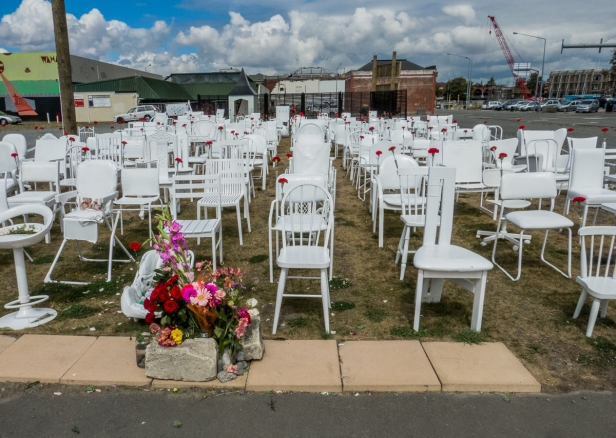
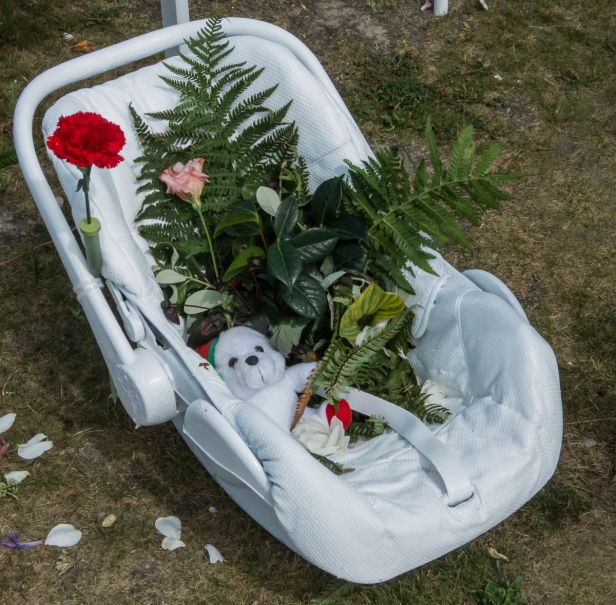
I’m not aware that there has been a fourth anniversary ceremony the day before, hence the carnations. I think that someone, or some group of people, care enough to keep replacing the carnations. I cry for the loss of lives, I cry for the destruction of what was obviously once a beautiful city, I cry for the fragility of life and the impermanence of all that is, and I cry for the carnations, that people care enough to place carnations on the chairs.
I try to hide my tears but do not succeed. A tour group arrives. While they look around the tour guide comes to me and asks if I’d lost someone in the quake. I tell her no and try to tell her why I am so moved. She explains about the carnations, that they’d been placed there the day before for the anniversary ceremony. She also tells me to look out for giraffes, that people are placing giraffes all over the city as a symbol of standing tall in the face of tragedy, but I don’t see a single giraffe in four hours of exploring the worst hit part of the town. What I do see in many places is this: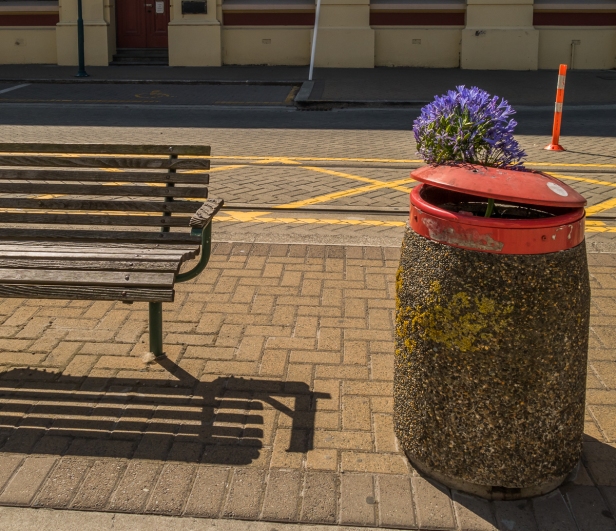
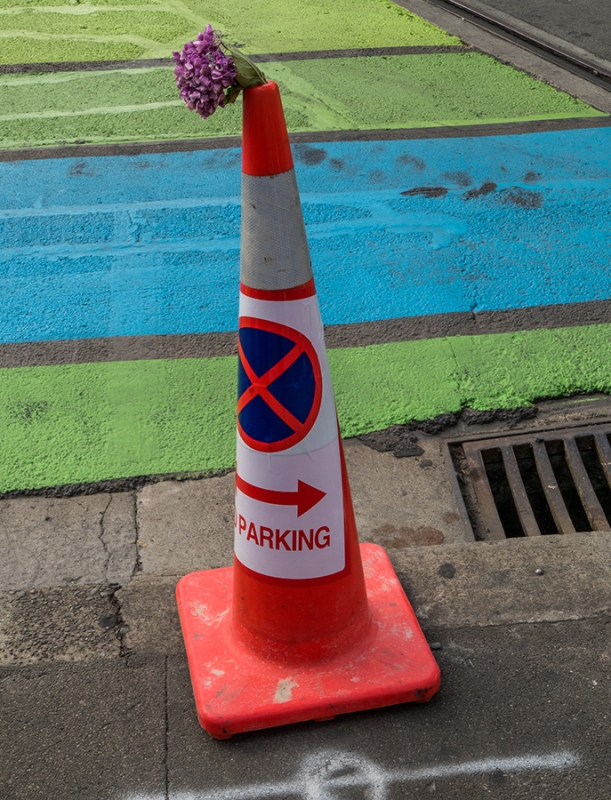
flowers placed into the holes in the tops of garbage bins, as well as in traffic cones and orange plastic construction barriers, which, along with metal fencing, are the predominant feature of Christchurch streets these days – a small act of beauty being spread amongst all the rubble and reconstruction that is going on all over the city. Construction cranes are the major element of the skyline of Christchurch now.
We first became aware of it walking from the hostel to the supermarket in our neighbourhood close by the downtown core: a remarkable number of empty lots next to lovely colonial style houses. At first it didn’t register, but then we realized that on each of those empty lots a house had once stood. Then we noticed a house boarded up with a sign in the window: Danger – Live Wires. It was when we went into the central core that the reality of the damage to the city became absolutely clear. Ten thousand homes lost, fifteen hundred commercial buildings lost, and several million tons of rubble left behind.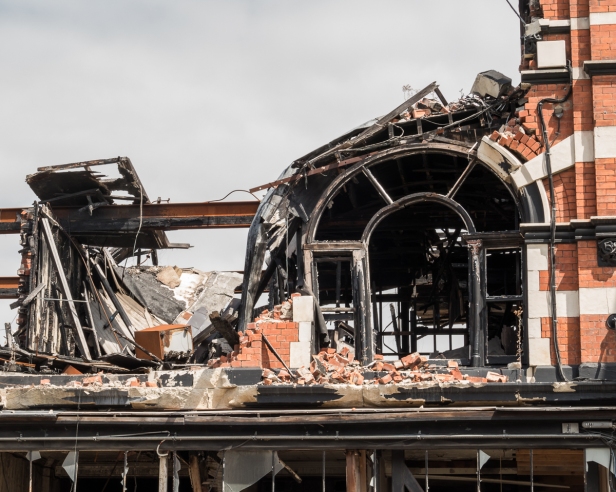
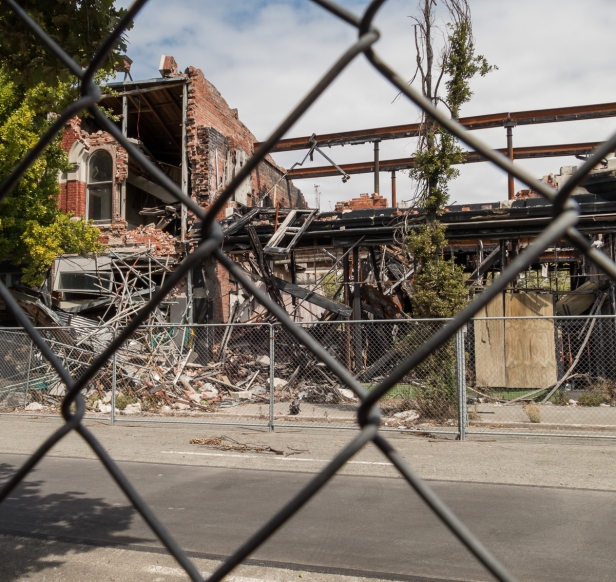

Many buildings are boarded up. Many are shored up with steel girders to prevent more collapse.
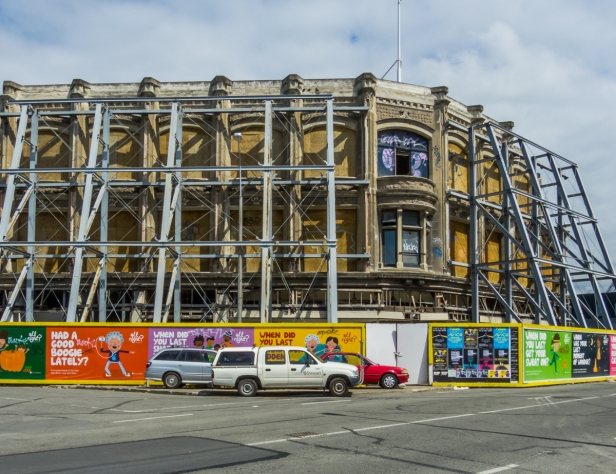

We walked by many buildings that seemed to be fine until we had a closer look.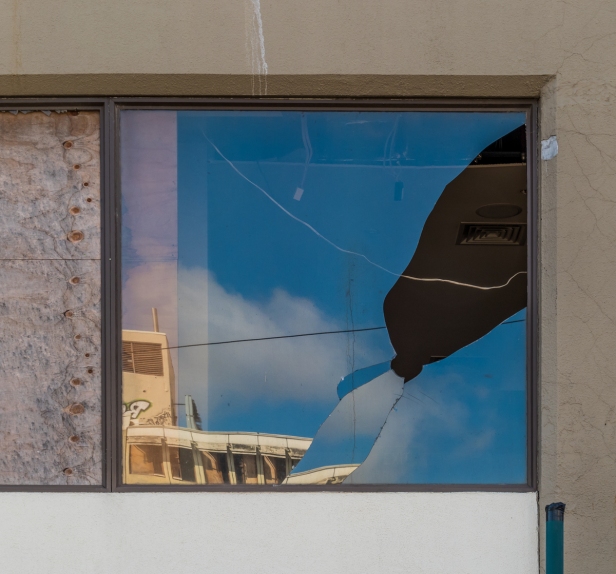
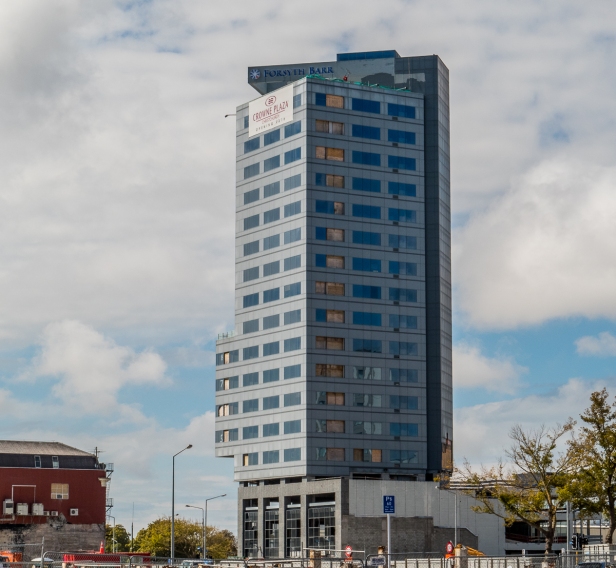
The devastation was all around us, streets blocked off with metal fencing, crumbling buildings, traffic flow somehow redesigned with orange barriers and traffic cones, and vacant lots everywhere.
In the midst of all this there is a massive amount of construction going on, and some wonderfully creative and unique new buildings. New ideas spring like flowers from the wreckage and the rubble. People are pulling together to rebuild their beloved town, with projects ranging from making public sculptures and furniture with salvaged wood, to creating small gardens to begin the re-greening of the city.
Quoting directly from the sign on the pavement: This stand of native rimu trees is a public art sculpture by NZ artist Regan Gentry. It uses wood felled for a family home, lived in and loved, salvaged post earthquake and returns it to an urban forest. It speaks to the city’s rebuild and to the challenges ahead for Christchurch.
Gentry’s trees soar high above the real trees that stand beside them.
Then there is the “Greening the Rubble” project. Transitional gardens are part of our city’s new identity. Their primary purpose is to create responsive public spaces that promote wellbeing and biodiversity. This is Pod Oasis, an example of their work.
A bigger project was the “Cardboard Cathedral”. The earthquake destroyed the tower of the neo-Gothic Cathedral. Aftershocks deeply affected the stability of the whole building, and shattered the famed rose window.
By chance a member of the Cathedral staff saw an article in a magazine about Japanese emergency architect Shigeru Ban. He had designed a cardboard church to replace the one that had been destroyed in the Kobe earthquake. A little over two years after the earthquake Shigeru Ban’s cardboard Cathedral opened in Christchurch. The building is made of huge tubes of cardboard, local wood, and steel, with a polished concrete floor and a polycarbonate roof. It is designed to last for at least fifty years and is built to 130% of New Zealand’s earthquake code. An exceptional and inspirational building. Emergencies often seem to produce extraordinary creativity.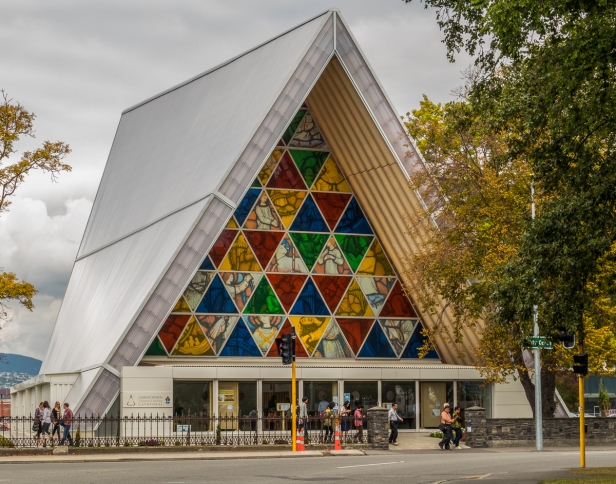
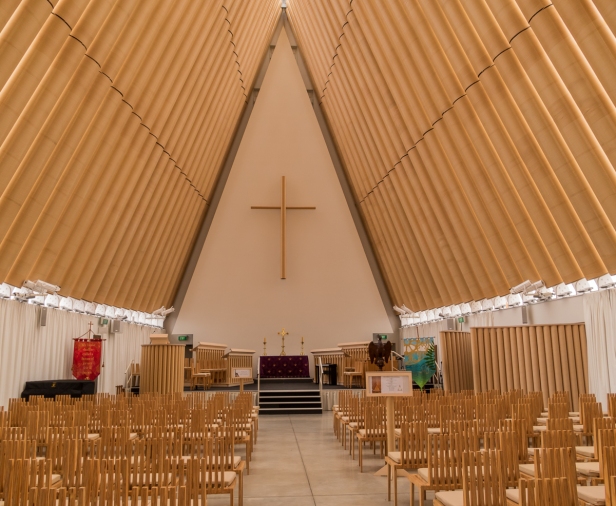
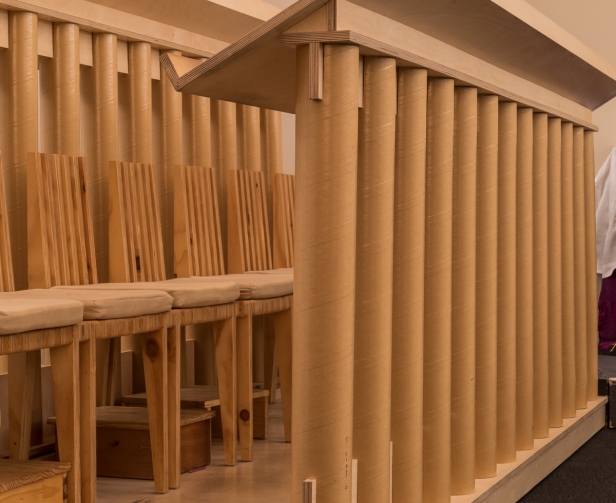
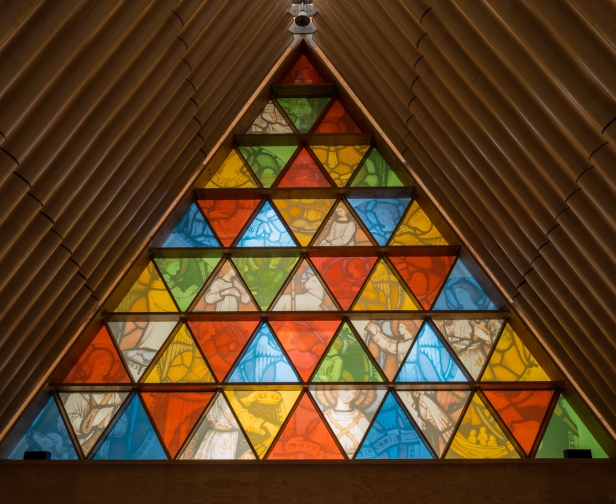
New Regent Street was the only street in Christchurch to have been planned as a whole. It was always a favourite with its Spanish Mission style architecture, its symmetry and coherent design, and its pastel colours. It was the first street in the downtown core to have infrastructure repairs done. The architectural features were painstakingly restored, and with great fanfare it re-opened almost exactly two years after the quake. Even before the earthquake New Regent Street was considered the most beautiful street in Christchurch. Today there’s no contest. The re-opening was an emotional milestone in the reclamation of the inner city.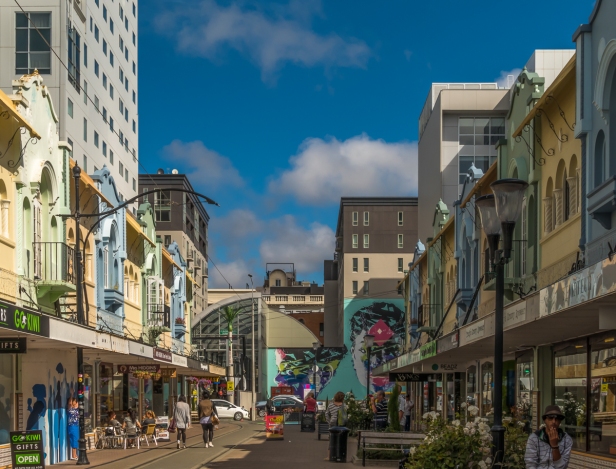
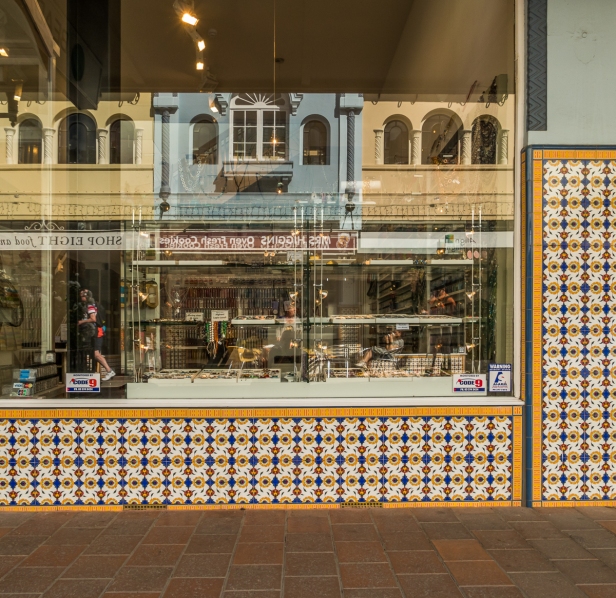

The beautiful and fanciful Peacock Fountain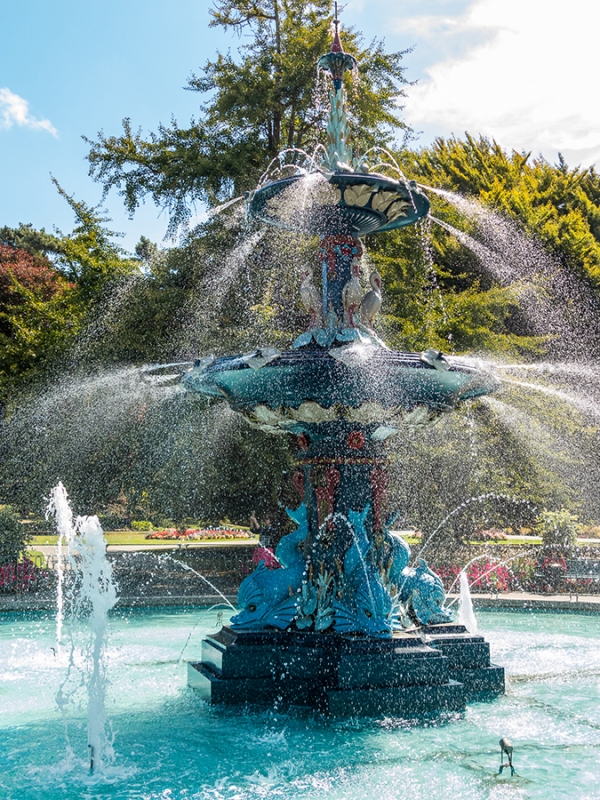
is located in the Botanical Gardens next to the Canterbury Museum. The solid Gothic Revival museum building is over 100 years old and sustained little damage. I mention it, even without a photo, because it indicates the style and feel of the old Christchurch, the pre-quake Christchurch: some of it still stands.
And in the traditional fashion of the city’s British heritage, you can still go punting on the Avon River.
The most striking, and perhaps the most famous, project to arise from the destruction of the city is Re-START. Re-START is a downtown pedestrian mall built from shipping containers. Containers are strong, stable, earthquake resistant and durable, but whoever would have thought to turn them into buildings? A remarkable idea indeed.
You can see from the photographs that the steel walls of the containers have been cut out where necessary, and replaced with glass in the case of exterior walls. Most stores consist of several containers joined together so of course the interior walls are left open. In some cases the original doors of the container have been left as an exterior wall, or as the functioning doors of the business. With the exception of the building shown immediately below, the upper containers are for display only. The whole affect is bright, cheerful, functional, and very modern. There is something very appealing and enticing about it. It’s a happy place to hang out.
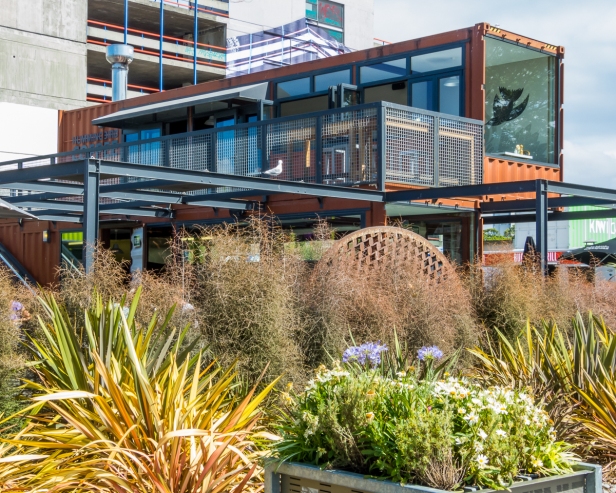
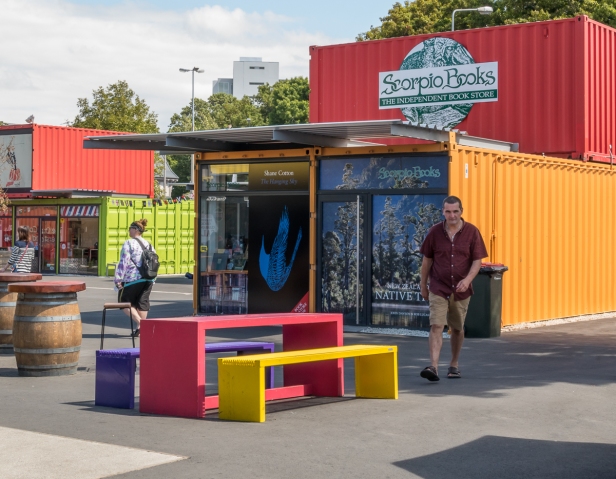
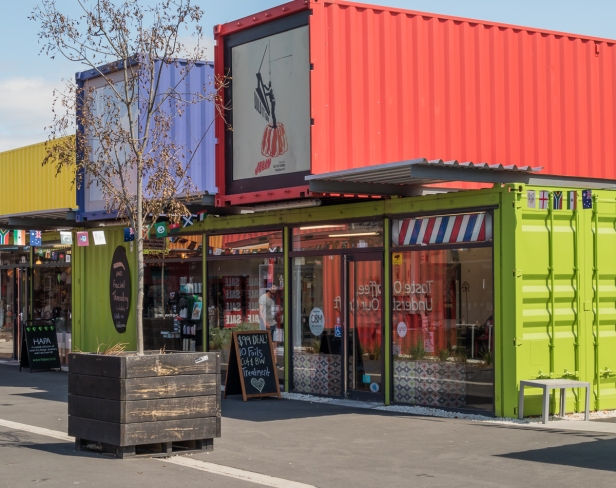
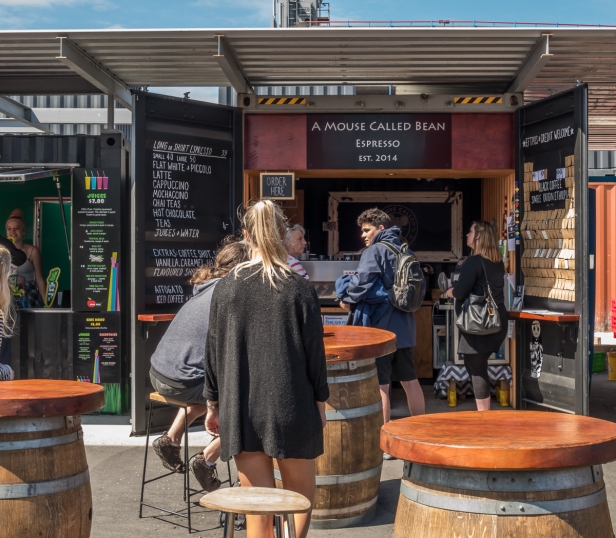

Christchurch is no longer the beautiful city it obviously once was, but I have no doubt it will be again. I have no doubt these resilient people will rebuild their city so that, although quite different, in every way it will be as good, and in some ways it will be even better than it was before. Bravo Christchurch for a strong and creative new beginning.
And so I must mention the tsunami that hit Japan less than a month after the Christchurch earthquake, the earthquake that shattered Haiti five years ago, Cyclone Pam that all but destroyed Vanuatu in March of this year, and of course the tragic and dire situation in Nepal after the earthquake of April 25th. In Nepal the death count is over seven thousand and will probably go higher. It has been difficult in Christchurch, but so much more so in undeveloped poor countries. Christchurch became very personal for me because I saw it first hand, thus these other situations become more personal also. More tears for the fragility of life and for the heartbreak it brings. But in the end I am moved most of all by the way in which people pull together and support each other in times of tragedy, by the innumerable acts of heroism and simple kindness, and by the seemingly infinite resilience of the human spirit.
All words and images by Alison Louise Armstrong unless otherwise noted
© Alison Louise Armstrong and Adventures in Wonderland – a pilgrimage of the heart, 2010-2015.

Oh my goodness, Alison. We heard so much about Christchurch for a few months and then it faded out of the news. Don’s photos and your words brought tears to my eyes, too. What an amazing and resilient lot of people the people of Christchurch are. Thank you for sharing it all with us. I hope Don’s back is OK again now. Warmest wishes, Ros
LikeLike
Thanks Ros. It brought more tears to my eyes as I wrote it. I’ve never been into a disaster area before, even 4 years later. It was really an eye-opener. The people are swinging back towards normal, well a new normal anyway, and there’s progress all round.
Alison
LikeLike
Alison, what a moving tribute to Christchurch and its people. Seeing the earthquake footage and photos of the destruction was heartbreaking, and on top of that the scenes from Japan less than a month later only added to the grief. I am glad to see New Regent Street restored to its former glory, and the immense creativity in the street art and newer structures like the Cardboard Cathedral.
I only have faint memories of Christchurch when I went in the 90s. But I do recall standing on the square and looking up at the gorgeous stone cathedral. My brother even remembers that we climbed the tower. Do you know if the rest of the structure will be saved or taken down?
LikeLike
Thank you so much James. But good Lord I can’t believe I forgot Japan and the tsunami – tragedy and heart break on massive scale. Life is so fragile and precarious. And I sometimes wonder if Earth is more restless or if we just have more knowledge of it these days.
The feeling is definitely one of renewal in Christchurch, but it still brings tears to my eyes when I think of the simple small act of beautification by putting flowers in the top if traffic cones.
The Cathedral cannot be saved. To quote the pamphlet handed out at the cardboard cathedral: “it [the cardboard cathedral] will eventually become the parish church of St John in Latimer Square when a permanent Cathedral is built again in Cathedral Square.
Alison
LikeLiked by 1 person
Thanks in turn for answering my question, Alison. As much as I loved the old cathedral, I think demolishing it is the right idea. Without the tower and rose window it is but a shell of its former self. And we don’t know how weak the structure is now – in the next quake what remains may kill more people. I guess this is an obvious point, but its replacement has to be earthquake-resistant and reflective of the new spirit of Christchurch.
LikeLike
Hi Alison and Don, Thank you for your lovely article. I visited Christchurch in 2003 and loved it. It was hard to hear about all the devastation at the time. It is great to see your pictures of a new city emerging from the rubble. I love the shipping container-shops in their bright colours. They seem like such a good idea for earthquake prone areas. I also love the cardboard cathedral. It will probably still be there many years from now.
LikeLike
Thanks Helen. We could really tell that it had once been a beautiful city from the buildings still standing and from photographs – much lovely old architecture and a garden feel. It will take a while to re-establish that but there is definitely a feeling of renewal. I too loved the container mall. That is one thing I knew about beforehand and really wanted to see it. I was not disappointed. The cardboard cathedral I’d not heard of before and was just amazed by it.
Alison
LikeLike
Such a heartfelt and beautiful post and what a comment about the strong and creative people of Christchurch who are rebuilding their city. I especially loved your photos of the Cardboard Cathedral and the downtown pedestrian mall – wonderful! Anita
LikeLike
Thank you so much Anita. It was a really moving experience, not only to see the destruction, but also to see the renewal and the resilience of the people. There’s a long way to go but things are definitely moving forward.
Alison
LikeLike
Ok; your first sentence prompted tears, and I cried with you through the first half, even the part about the giraffe’s symbolizing ‘standing tall.’
I admired the improvements and marveled at the beauty and am glad that my interenet signal was strong enough to load the page and allow this comment!
Thanks for another great post,
Lisa/Z (at sunrise)
LikeLike
Thanks Lisa. Sorry to make you cry. I still get a bit teary just reading about it, and was definitely very teary while writing it. The bit about the wood for Gentry’s trees coming from a family home, lived in and loved, gets to me every time. And it’s not just the destruction, it’s the renewal and acts of beauty and kindness that get me. Wish I’d seen a giraffe.
Alison
LikeLike
Hi Alison, like you I feel sad with thoughts of how fragile life is and how it can end so abruptly and tragically. It is so unfair. You told the story of Christchurch’s rebirth in a very emotional and heartfelt way, it brought tears to my eyes, but also your last paragraph is a great tribute and a reminder that there are other’s also suffering a great deal. The human spirit and ability to recover and rebuild is indeed inspiring.
LikeLike
Thank you so much Gilda. It still brings tears to my eyes. Especially all the *good* that comes out of tragedy brings tears to my eyes. And yes, inspiring.
Alison
LikeLike
Well put Alison and great pictures Don. I´m pleased to hear that Christchurch is rebuilding. It is amazing how people do bounce back from these disasters. I would have burst into tears as well.
LikeLike
Thanks Darlene. There’s a strong feeling of people going about their lives now, not back to normal, but adjusted to the new normal. People do bounce back. I think we’re all far stronger than we think we are, and times of tragedy tend to show us that.
Alison
LikeLike
Living in a disaster-prone country helps me understand how it feels when natural disasters hit. But humans are truly resilient. It is often during such difficult time we show our best qualities. It’s really encouraging to see how Christchurch is rebuilding itself from the rubble.
LikeLike
Oh Bama I’m sorry I forgot to mention the Banda Aceh tsunami. Like the tsunami that hit Japan in 2011 (which I also forgot to mention!) I can’t even begin to imagine the scale of destruction and heartbreak. At the same time I do agree that people are resilient, stronger than we think, and that, as you say, during difficult times we show our best qualities. Christchurch is doing well I think. People are going about their lives, things are moving on. For all the travelling we do, Don and I lead sheltered privileged lives. I’ve never been in a disaster are before, even 4 years after the fact. It was shocking.
Alison
LikeLike
From these words & images
i’m impressed with their acknowledging pain
& then renewal of spirit these NZ people
generate to go on, beautifully 🙂
LikeLike
These NZ people
are strong of heart
and strong of spirit.
Inspired creativity
and love – powerful potion.
Alison
LikeLiked by 1 person
Bravo, you two. Beautifully documented.
LikeLike
Thanks so much Pam. It was such a moving time: shocking, and uplifting, all at once.
Alison
LikeLike
This is an awesome post. Thank you for sharing it with such amazing pictures, too. Love seeing what you guys are up to! Love, Karen
LikeLike
Thanks so much Karen. So glad to hear you’re following along on our journeys, and that you’re enjoying the blog.We often think of our time in La Manz and how idyllic it was, and your fabulous yoga classes. Hope we get back sometime – would love to spend more time there.
Hugs from us.
Alison
LikeLike
My trips to Christchurch were all before the earthquake, but I remember it at being a beautiful town. Living in California, I am no stranger to earthquakes and have seen the destruction they can cause.
Nothing struck me more powerfully though that the damage caused by Hurricane Katrina in New Orleans. I travelled through the city a month or so after the devastation.
A moving blog and photos. Thanks Alison and Don. –Curt
LikeLike
Thanks Curt. I’m not surprised to hear that Christchurch used to be a beautiful city – enough remains to show that – the river, some buildings, some gardens. I certainly got the feel it was once a lovely English style town. As I said in other comments this was my first experience of this kind of destruction – how vulnerable we all are. In the blink of an eye it can all come crumbling down. I imagine your trip through New orleans after Katrina was a pretty raw experience. Just this small taste, 4 years later, gives me a much more personal sense of the destruction and devastation.
Alison
LikeLike
A blink of an eye is right Alison, as Nepal now tragically knows. And the earthquakes can be so incredibly powerful. At least with a hurricane you have some warning. But I could hardly fathom the destruction in New Orleans.
–Curt
LikeLike
What a beautiful tribute to loss and new life, Alison. And Don – yourphotos of the white chairs would have gotten to my heart even without knowing the story.
LikeLike
Thanks so much Kay. I found the whole experience shocking and moving and very uplifting. Don definitely got the best photos of the white chairs! I had one of mine ready to go but then I looked through his and saw he’d done a better job of capturing the memorial.
Alison
LikeLike
Thanks for the feedback Kay. It’s odd, but I’ve had more of an emotional response to what we saw in Christchurch from reading Alison’s post and all the comments that have come in about it than I did when we were there in person. Maybe it was just too overwhelming at the time, seeing all the destruction.
LikeLike
Christchurch has the potential to be rebuilt to be incredible, from seeing what has been done so far looks like it is in on the right track
LikeLike
I think it’s definitely on the right track – there’s so much creativity coming from the destruction that’s exciting to see. I think people have adjusted to the new normal and although things will never be the same, perhaps things are at least okay now and will gradually get better and better as the rebuilding continues.
Alison
LikeLiked by 1 person
I was moved beyond words to read your account of Christchurch; the devastation, the memories and the strength to rise again. A very different blog post from your others, yet this too is life in all its splendor and pain. Thanks for sharing your emotions and images.
LikeLike
Thanks Helga. I was moved to tears again just writing the post. Moved by the heartbreak and moved by the goodness that seems to arise in times of tragedy. I’m so glad we went there.
Alison
LikeLike
It’s simply astounding. The depth of what’s happening. The language it speaks. The way empty chairs, and flowers left in caution cones for others to see, remind of the vastness that is swallowing us whole a little each day. We don’t live in the world we think we live in. We live in a much greater one. A much riskier one. One in which we really could lose ourselves, if we let it all sink in… It’s simply astounding.
Michael
LikeLike
Yes, it is astounding. In situations like this I feel I am connecting with something ineffable, and it is that connection that brings the tears. It’s some sense of the rightness of things whether it’s heartbreaking destruction or joyous renewal. It’s all the same. Everything is a risk. And nothing. Only Love will remains.
Alison
LikeLiked by 1 person
I hear an echo from your latest post, A Secret About Me, in which you consider the possibility of giving up all your aspirations because ‘He wants me to run on empty.’ That’s the real risk isn’t it, to drop all our aspirations, hopes and dreams in order to be fully present with whatever is in each and every moment. We really could lose ourselves totally, but then ‘This heart of mine understands me perfectly,’ and then only love remains.
Thank you for your always deeply thoughtful comments.
Don
LikeLiked by 1 person
What a wonderful post about our wonderful city. We are proud Cantabrians and have been here throughout the earthquakes and rebuild. It was so interesting to see Christchurch through the eyes of a visitor. I love reading your blog and am in awe of the way you choose to live your lives. I didn’t know you were coming to New Zealand as I have been off line for a bit and would have loved to meet up with you in Christchurch. Are you still here or do you have plans to return?
Andrea
LikeLike
Thank you so much Andrea, I’m so glad you enjoyed the post about your wonderful city. We would have loved to get together with you if only I’d remembered you’re in CHCH. I need to make a list of all the active blog followers and where they live so I can check in with people ahead of time.
We are currently in Hawaii and fly to Vancouver tonight for 2 months then off to Europe for a few months, so no plans to return at this point.
Alison
LikeLike
Wow. I agree with everyone above. Beautiful tribute in words, and as always, marvelous photos. And Don’s getting in on the photos too! Love the chairs shot.Now I can see why you were so sensitive and teary at my site, maybe? This is a long post to be feeling all that emotion.
LikeLike
Thanks badfish. Yeah, very emotional in CHCH and very emotional later while writing this post (but not related to your post which was about the world’s cruelty). I’m glad we went. It was in the end a heart opening experience and I was most moved by the rebirth and the spirit of the people. Don’s photos of the chairs were way better than mine!
Alison
LikeLiked by 1 person
I visited Christchurch well before the earthquake and loved it. My parents went a few months after it happened and said it was so sad. I’m glad that rebuilding has happened. It really is a beautiful town. The chairs would have made me cry my heart out.
LikeLike
From what we saw that was still intact it was clear that it had been a beautiful city. The rebuilding is taking time but people seem to have adjusted. I think the giraffes are a wonderful symbol of the mood of the city.
Yeah, the chairs – still brings tears just thinking about them.
Alison
LikeLike